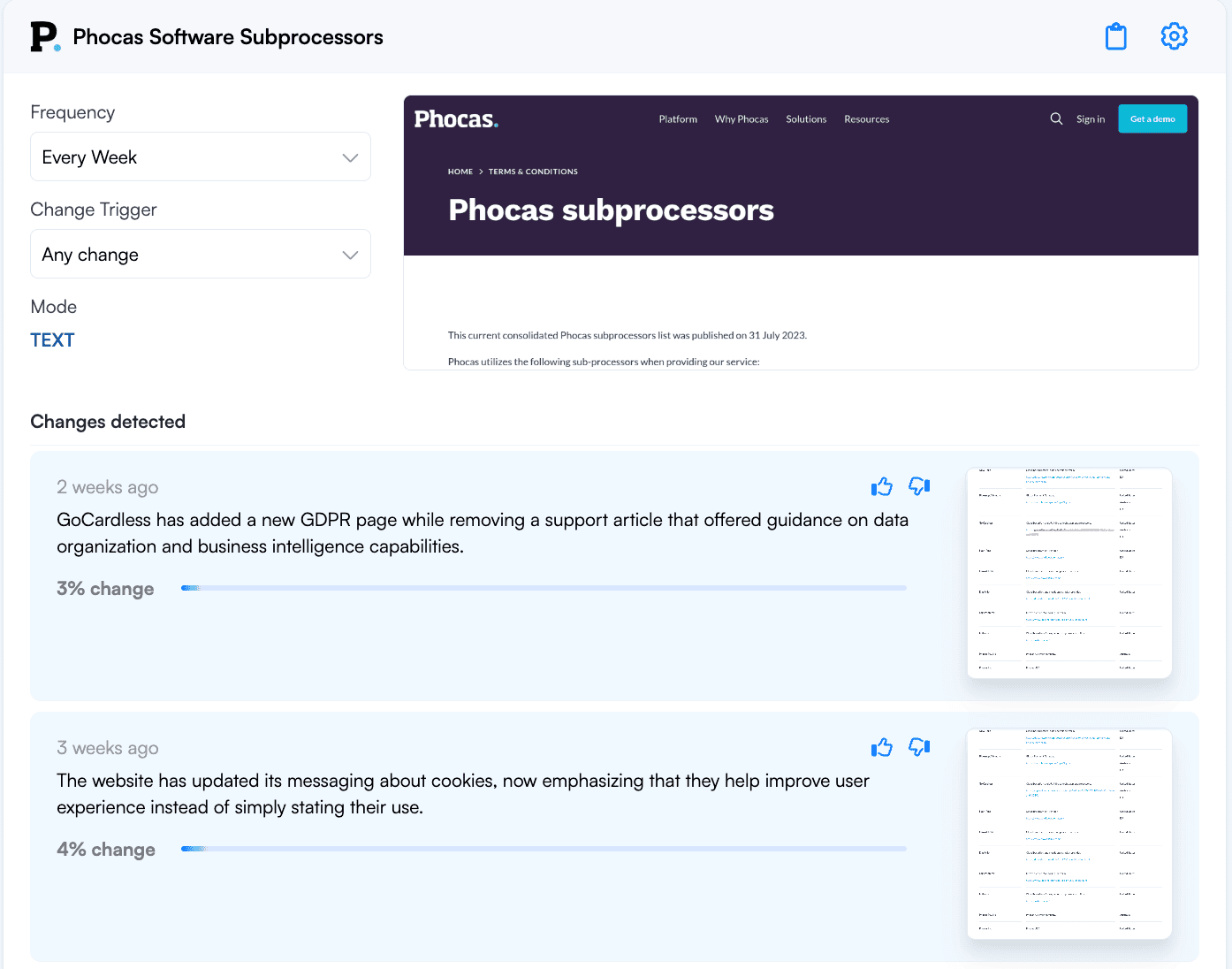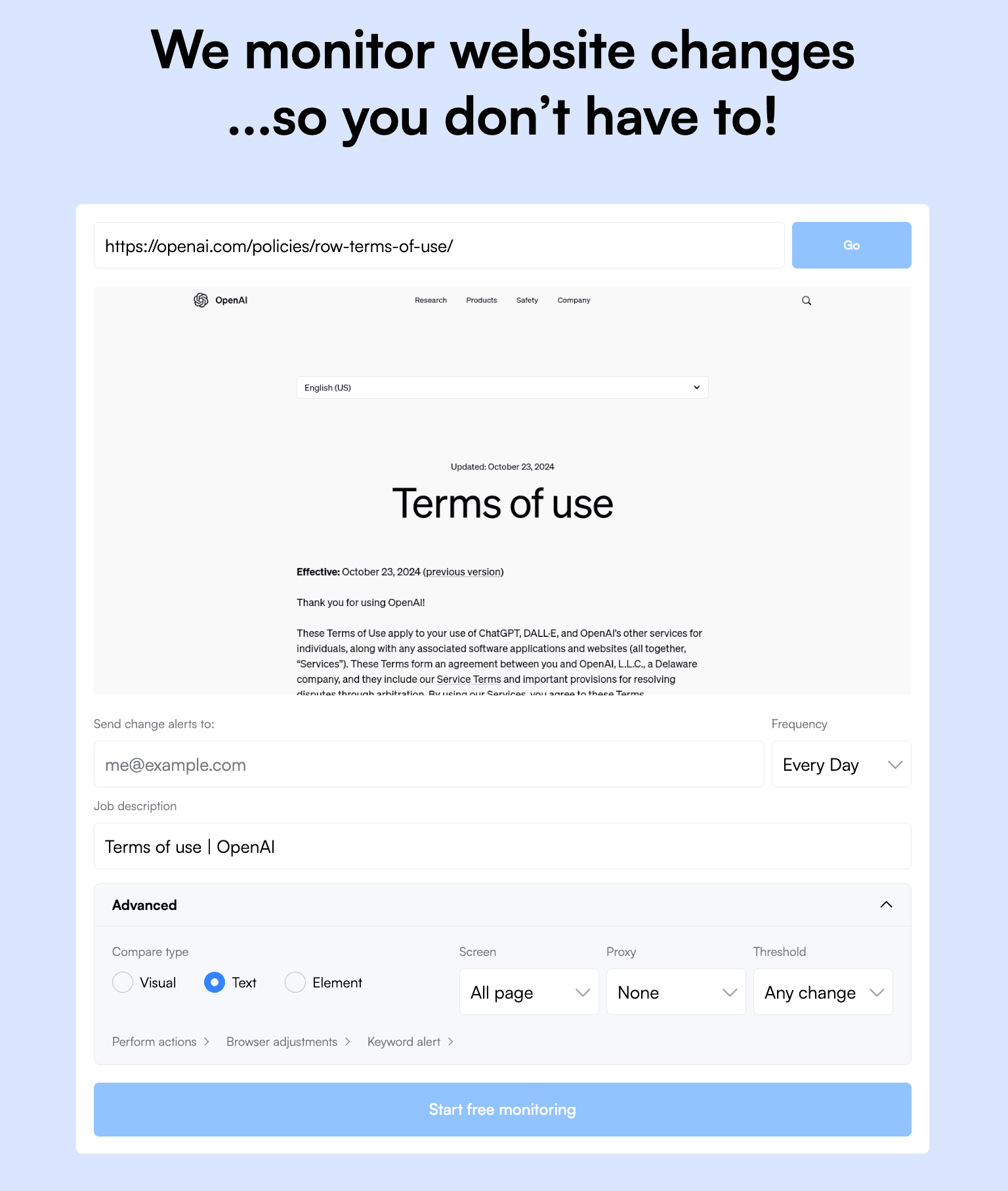How to Monitor Changes in Terms and Conditions (T&Cs)?
By Emily Fenton
Updated October 11, 2024

Terms and conditions (T&Cs) change at ever-increasing rates, especially for SaaS services and cloud-computing providers. But nobody enjoys sifting through the plethora of mind-numbing legalese the first time – better yet every time it changes.
Follow these simple steps to monitor terms and conditions by receiving email alerts with easy-to-read snapshots of the updates, conveniently highlighted for your perusal.
A Terms and Conditions Agreement (T&C) is one of the most essential legal documents for companies to incorporate on their webpages and apps.
Software as a Service (SaaS) companies, where the majority of software is sold from nowadays, rely on terms and conditions to grant users a license to use the software and to specify the rights and restraints pertaining to its use. User restraints include the user’s ability to copy, modify or redistribute it, as well as the limits on the liability of the developer.
Terms and Conditions (Quietly but Surely) Change
As neither businesses nor laws are stagnant, an agreement drafted today between a company and their customers may not be the same agreement tomorrow. Websites updates their T&Cs due to, for example, updated business models, adding or removing product features, or to follow compliance requirements from new laws.
Some businesses reserve the right to change their terms and conditions at any time, without informing their users. When you install new software for your company, you are not only agreeing to all of today’s ubiquitous terms, but to the future’s ubiquitous terms, too.
Yes, it's true: even if you take the time to read and understand the current T&Cs (most of us don’t), it could change to a completely different agreement and you wouldn’t even know.
For some companies, undetected changes to terms and conditions can escalate into serious problems. Visualping has many clients monitoring the T&Cs of the software they use. One example is a California state school district, who uses software in the classroom with 64,000 students. Their legal team needs to ensure they are notified of content restriction changes, as some content isn’t suitable for children under 13 years old. Just imagine all the angry parents.
Other clients include heavily regulated industries such as banks, insurance companies and attorneys from large corporations who do not have the time, energy nor patience to sift through hundreds of T&Cs used by staff and employees but, nonetheless, need to be aware of these changes.
Admit It: You Don't Want to Manually Monitor T&Cs
It doesn’t help T&C Agreements are often too confusing and complicated for the average reader to understand.
In March 2012, the PayPal End-User License Agreement consisted of 36,275 words and, in May 2011, the iTunes agreement included 56 pages, with words like “mercantile agent” and “material breach”, written in HUGE BLOCKS OF CAPITALIZED TEXT THAT ARE SOMEHOW URGENT AND IMPENETRABLE AT THE SAME TIME, IN A LANGUAGE SO ELUSIVE IT IS IMPOSSIBLE TO UNDERSTAND WHAT YOU ARE READING AND SO users tend to simply opt for the I Agree button and never look back.
Even if those changes are significant to them and/or their company.
Many companies actually require customers to agree beforehand that they will intermittently reassess their contracts on the company's website for changes. One example is Network Solutions’ service agreement that requires customers to agree to “periodically review [their] Web sites […] to be aware of any such revisions” before signing up for its services.
When pasted into Microsoft Word, the agreement is 102 pages of single-spaced text.
And while some services will notify users of changes, they often direct users to the updated T&Cs without marking or explaining the changes explicitly. With a 102-page contract, that’s a lot of time manually checking for changes.
Monitor Terms and Conditions with Visualping
Put simply, it is imperative users and companies are aware of what they are signing up for, when this agreement changes and whether the change is material to their business.
But while monitoring terms and conditions is an arduous administrative task, with the proliferation of free and easy-to-use automation services like Visualping, you can forget about the painstaking endeavor of monitoring T&Cs, scanning the text yourself.
Visualping is the world’s leading change detection tool. A website monitoring service with 1.5 million users – out of which 83% are Fortune 500 companies – Visualping offers users different ways to monitor website pages, from visual to text webpage elements.
When monitoring changes to a T&Cs page, we recommend using our Text Compare feature.
When there’s a change to the T&Cs page, Visualping will automatically send you an email alert. With Text Compare, the email will display a snapshot of all the webpage’s textual updates for you to view. Text that was added to the page is highlighted in green. Text that was removed is highlighted in red.
And if you want to view the highlighted changes within the context of the actual webpage you’re monitoring, you can select the View Changes option at the bottom of the email . You’ll be taken to your dashboard, where you can get a closer look at the screenshots within the context of the website.
 Staying on top of these changes to your company’s software does not have to be as wearisome as it sounds. With Visualping, you can receive convenient notifications regarding changes to terms and conditions, conveniently highlighted through our change detection system.
Staying on top of these changes to your company’s software does not have to be as wearisome as it sounds. With Visualping, you can receive convenient notifications regarding changes to terms and conditions, conveniently highlighted through our change detection system.
Visualping will streamline the process, saving you from intermittently sifting through blockades of dense text.
And setting it up is a breeze.
How to Monitor Terms and Conditions Using Visualping
- Step 1: Copy and paste the URL of the T&C page you wish to monitor into the search field on the Visualping home page. Click Go.

- Step 2: The page will appear our screen monitor. In Advanced Options, select Text-Compare to track textual changes on the T&C page.
- Step 3: Choose the frequency of checks you would like our system to check for T&Cs changes – every 5 minutes, hour, day, week, etc.
- Step 4: Enter the email you wish to use to receive change notifications.
- Step 5: Type in the name or label associated with the page.
- Step 6: After having clicked the link sent to your email to verify your address, complete the sign-up process.
After confirming your email, Visualping will deploy the notifications to your inbox.
You are now equipped to monitor terms and conditions and receive email alerts when your T&Cs change.
Our examptual play on GameStation's April Fool's joke, when hundreds of thousands of users could have benefited from Visualping’s notification system to avoid unknowingly agreeing to their sneaky T&C update. ; - )

Happy monitoring!
Want to stay on top of non-compliance?
Sign up with Visualping to detect issues from any web page online – before your business is on the line.
Emily Fenton
Emily is the Product Marketing Manager at Visualping. She has a degree in English Literature and a Masters in Management. When she’s not researching and writing about all things Visualping, she loves exploring new restaurants, playing guitar and petting her cats